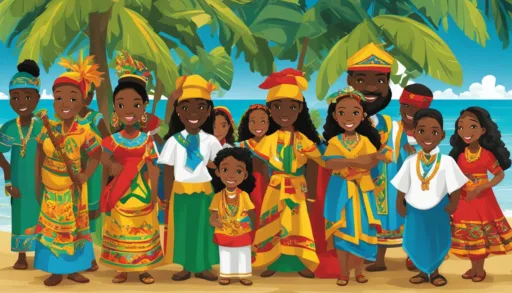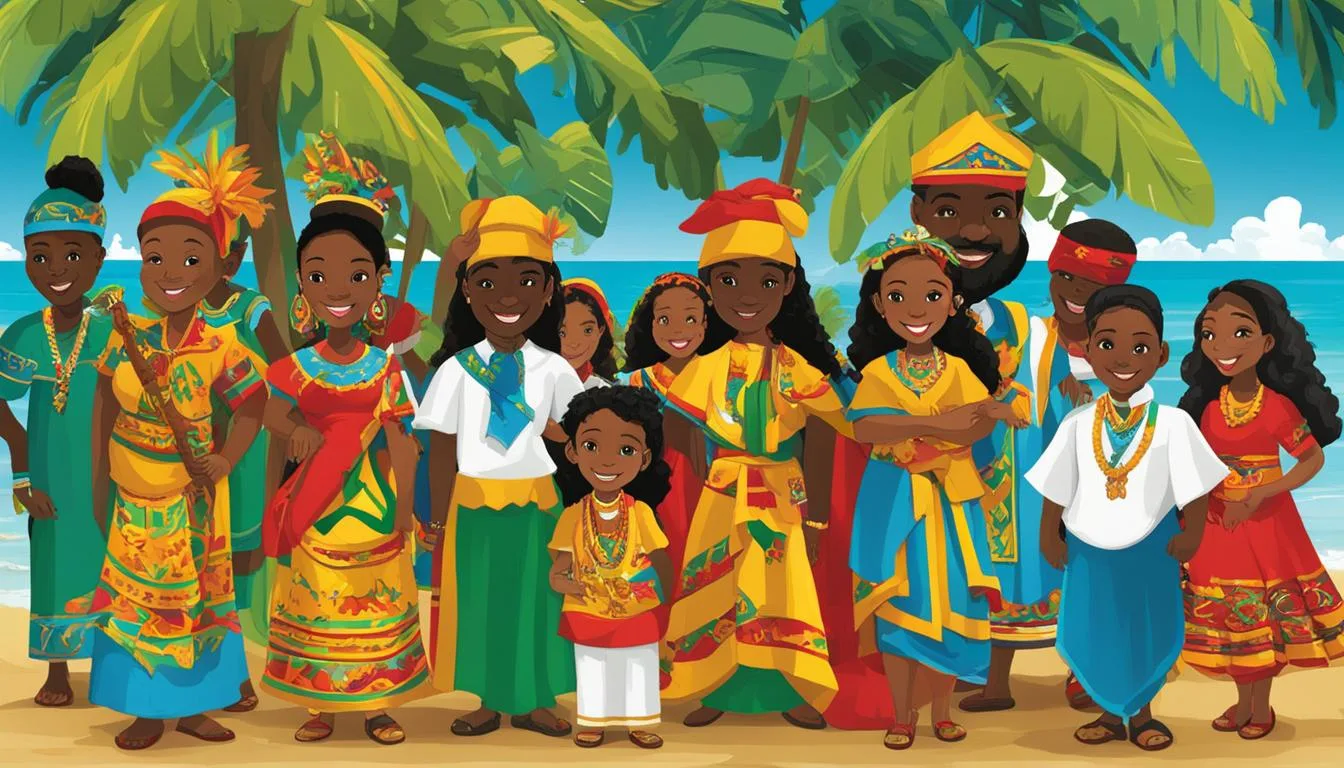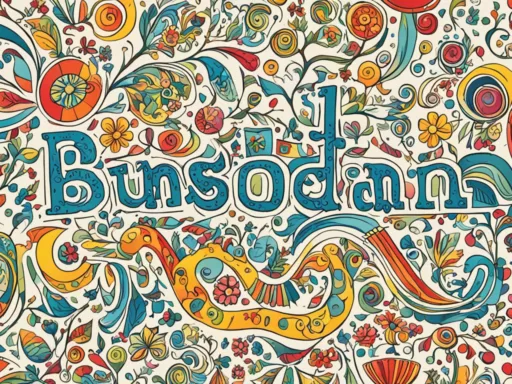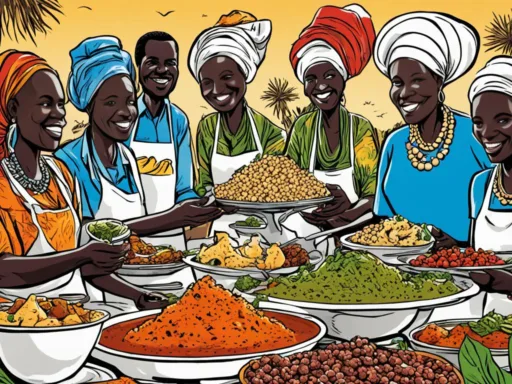While many Caribbean islands boast a mix of cultures and languages, few can claim a linguistic quilt as intricate as Saint Lucia’s. In a place where **languages spoken in Saint Lucia** are an audible tapestry of history and identity, an astounding 95% of the population is fluent in a language that is neither the island’s official tongue nor the most globally dominant one. This language is Saint Lucian French Creole, better known as ‘Kwéyòl’, which weaves together elements of French, West African dialects, and the Island Carib language. It stands as a vibrant emblem of **Saint Lucia’s multilingual society** and its significant **language diversity**.
Key Takeaways
- English is the official language of Saint Lucia, reflecting the island’s colonial history with Britain.
- Saint Lucian French Creole (‘Kwéyòl’) is widely spoken, embodying the island’s **language diversity**.
- The blending of French with African and Carib influences signifies Saint Lucia’s rich multicultural past.
- Despite English’s official status, Kwéyòl remains a strong pillar of Saint Lucia’s **multilingual society**.
- Cultural recognition is growing for Kwéyòl, further cementing its role in the local linguistic blend.
The Linguistic Landscape of Saint Lucia
Saint Lucia’s rich tapestry of cultures has given rise to a distinctly multilingual society. This vibrant linguistic diversity traces its origins to the island’s complex historical affiliations and cultural interactions.
Overview of Saint Lucia’s Multilingual Society
In the heart of the Caribbean, Saint Lucia is a beacon of language diversity. Here, the official languages of Saint Lucia encompass both English and French Creole, the latter also referred to as Kwéyòl. Underscoring its status as a multilingual society, the island welcomes a melange of languages spoken on its shores, reflecting its rich heritage and the amalgamation of European and African influences.
The Role of Language in Cultural Identity
The fabric of Saint Lucian society is interwoven with linguistic strands that are as varied as they are dynamic. English serves as the cornerstone for formal education and governance, yet it is within the cadences of Kwéyòl where much of the island’s soulful expression dances to life. The languages spoken by Saint Lucians are not mere tools for communication but are indeed pivotal to the cultural identity that sets the island nation apart.
| Language | Usage Context | Origin Influence |
|---|---|---|
| English | Official proceedings, education | British colonial history |
| Kwéyòl (French Creole) | Casual conversation, cultural events | Blend of African, French, Carib languages |
| Other Minority Languages | Community-specific communication | African, East Indian heritage |
English: The Official Language of Saint Lucia
English, designated as one of the Saint Lucia official languages, has played a pivotal role in shaping the island’s national identity and governing systems. The prevalence of this language today can be directly linked to Saint Lucia’s colonial past and its development over the centuries.
The Colonial Legacy and Language
The entrenched influence of English in Saint Lucia’s societal frameworks is a reflection of a complex colonial history. Initially marked by competing French and British claims, the eventual British dominion laid the groundwork for English to become the linguistic unifier across the island.
Education, Government, and Media in English
In today’s Saint Lucia, English is synonymous with official communication and is omnipresent, from government buildings to classrooms. It continues to be the main language used in educational institutions, reinforcing its status within the country’s multilingual society.
| Aspect | Role of English |
|---|---|
| Education | Primary language of instruction in schools and higher education |
| Government | Official language used in parliament, legal system, and administration |
| Media | Preferred language for newspapers, radio, and television broadcasting |
| Signage | All official signs and public instructions are in English |
The extensive use of English in these critical domains not only facilitates a cohesive social environment but also promotes an inclusive approach toward administrative transparency and educational parity.
Saint Lucian Creole French: A Rich Linguistic Heritage
Anchored deeply in the heart of the Caribbean’s culture-rich waters, Saint Lucia’s linguistic heritage stands out with its vibrant Saint Lucian French Creole. A language that echoes the island’s history and celebrates its multicultural influences, Saint Lucian French Creole is a cornerstone of Saint Lucia language diversity and a bridge connecting the present to its colonial past.
Born from the soil of French colonization, Saint Lucian French Creole intricately weaves African lexicons with the elegance of French linguistics, embellished further by the now-subtle Carib contributions. This linguistic amalgamation is more than a patois; it is a dialogue of identities, serving as one of the common dialects in Saint Lucia that holds the stories of generations and reflects the nation’s journey through time.
Despite its divergence from standard French, Saint Lucian Creole maintains intelligibility with Creoles of the Lesser Antilles and Haitian Creole, bearing witness to a shared cultural saga across the Caribbean. At the heart of national pride, this language flourishes during Jounen Kwéyòl, an annual celebration that honors its existence and ensures its continuity.
- Music and Oral Traditions: Captured in the rhythmic beats and folk songs that animate the local ambiance and connect the past with the present.
- Literature: Documented in tales and poems, Creole reflects the depth of Saint Lucian storytelling and literary arts.
- Communal Celebrations: From street fairs to kitchen corners, Creole encapsulates the jubilant community spirit and remains a staple in everyday communication.
True to its nature as a language of the people, Saint Lucian French Creole forms an irreplaceable link in the unbroken chain of the island’s language diversity. Below is a snapshot depicting the role that Creole plays in various aspects of Saint Lucian culture:
| Cultural Aspect | Influence of Saint Lucian Creole |
|---|---|
| Education | Curricula and programs have been established to promote the learning and preservation of Saint Lucian Creole. |
| Media | Creole is utilized in radio and television broadcasts, connecting speakers to local news and entertainment. |
| Cuisine | Traditional recipes and culinary terms are often expressed in Creole, enriching the gastronomic experience. |
| Festivities | Jounen Kwéyòl and other festivals feature Creole prominently, showcasing the language’s role in cultural heritage. |
Through its persistent vibrance and unyielding presence, Saint Lucian French Creole remains not only a testament to the island’s past but a living, breathing aspect of its modern-day character. It stands as an emblem of Saint Lucia’s language diversity, a dialect that captures the essence of the island’s enduring legacy and its promise for the future.
Understanding the French Influence on languages spoken in Saint Lucia
The fabric of Saint Lucia’s language diversity is intricately woven with threads of French influence. As we delve into the historical and linguistic underpinnings of this influence, it’s essential to recognize how it has sculpted the island’s communication and cultural identity over centuries.
Historical Context of French Dominance
The era of French dominance in Saint Lucia has left an indelible mark on the island’s language profile. Throughout the tumultuous colonial period, the seesaw of power between the British and the French heavily affected the linguistic development of the island, giving rise to the prevalence of Saint Lucian Creole French amongst the common dialects in Saint Lucia.
The Development of Creole from French and African Origins
As a linguistic reflection of Saint Lucia’s rich history, the creation of Saint Lucian Creole French, also known as Patois, stands as a unique combination of French and African linguistic traditions. This evolution resulted in a distinct language with its own syntax and grammar, which diverges from traditional French, encapsulating the fusion of the island’s colonial legacy with African influences and contributing significantly to Saint Lucia language diversity.
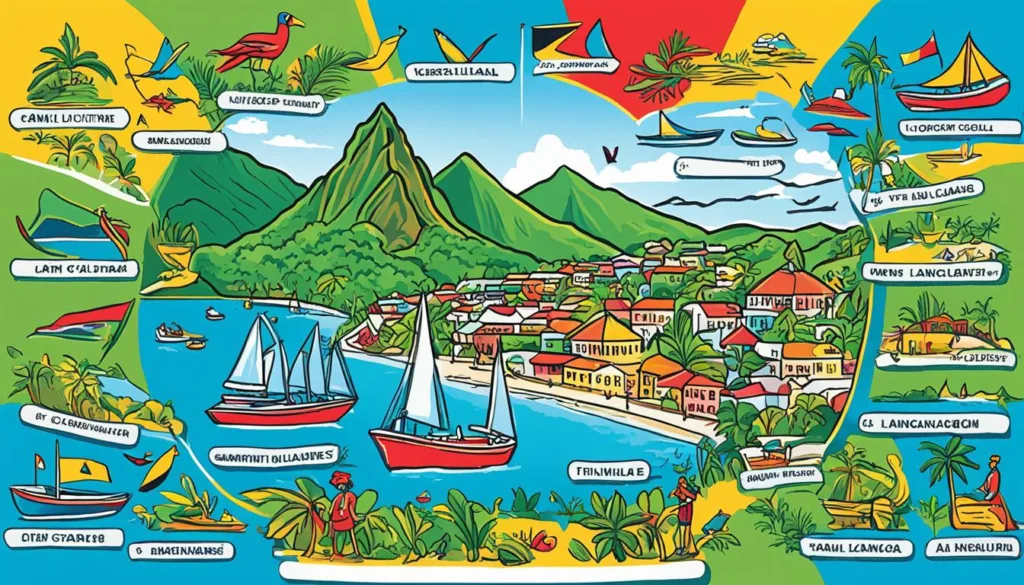
Understanding the language evolution in Saint Lucia provides insight into the complex cultural tapestry that defines the nation’s identity. It also underscores the importance of recognizing and preserving the uniqueness of Saint Lucian Creole French, a living testament to the historical forces that have shaped this enchanting Caribbean island.
Common Dialects in Saint Lucia and Their Origins
The linguistic landscape of Saint Lucia is a remarkable blend of various tongues, each with a story deeply rooted in the island’s rich history and cultural interchanges. Understanding the common dialects in Saint Lucia offers insight into the complexities of the island’s language diversity and its multilingual society. At the heart of this diversity resides the Saint Lucian French Creole, a creole language born from the interweaving of African and French Patois patterns.
The Blend of African and French Patois Patterns
The synthesis of African linguistic patterns with French Patois has been instrumental in shaping the core dialect that is Saint Lucian French Creole. This captivating dialect serves as a cultural beacon, shining light on the past dominions of African and French influences across the island. The linguistic structure of Saint Lucian French Creole is a mirror reflecting the seamless fusion of these powerful historical narratives.
Influence of Other Languages on Saint Lucian Dialects
Other languages, notably English, Spanish, and the native Carib language, have punctuated the development of Creole, crafting a distinctive lexicon and a repertoire of expressions unique to the island. These influences have significantly contributed to the broadening of Saint Lucia’s linguistic tapestry, offering a plethora of words and phrases that are hallmarks of the island’s cultural amalgamation.
| Linguistic Influence | Origin | Impact on Saint Lucian French Creole |
|---|---|---|
| French Patois | French Dominance Period | Provided foundational grammar and vocabulary |
| African Languages | African Heritage | Influence on Creole syntax and rhythmic patterns |
| English | British Colonial Rule | Introduced Anglicisms and official capacity language terms |
| Spanish | Regional Interactions | Added various words relating to food, music, and social interactions |
| Carib Language | Indigenous People | Enriched Creole with terms related to local flora, fauna, and place names |
Languages in Saint Lucia’s Education System
The quaint island nation of Saint Lucia is not just a tropical paradise but also a vibrant multilingual society. Its education system mirrors the country’s lingual richness, offering an intriguing look at how language diversity can be incorporated within an academic framework. The official language, English, provides a consistent medium for instruction and administrative communication, making the nation an accessible destination for international education.
In addition to the widespread use of English, Saint Lucia’s dedication to celebrating its Creole heritage is evident in the classroom. Dissemination and preservation of Saint Lucian French Creole in schools underscore a deep commitment to fostering a sense of identity and language diversity. This balanced approach not only equips students for the global stage but also roots them firmly in their cultural soil.

Here is an overview of language incorporation in Saint Lucia’s educational landscape:
| Language | Role in Education | Materials and Aids |
|---|---|---|
| English | Primary medium of instruction | Textbooks, Online resources |
| Saint Lucian Creole | Cultural studies, Optional language courses | Creole dictionaries, Literary works |
This approach to education contributes to the tapestry of language diversity on the island, ensuring that each student remains connected to the global community while appreciating their unique heritage. It also positions Saint Lucia’s education system as a model for other multilingual societies attempting to navigate the complex interplay between global languages and indigenous dialects.
As educators and policymakers continue to innovate, the commitment to multilingual education appears poised to grow. The continued use of robust language aids and dedicated learning materials ensures that even as English maintains its global significance, Saint Lucian French Creole will not be relegated to the footnotes of linguistic history.
Significance of Creole in Saint Lucia’s Cultural Expression
The vibrant essence of Saint Lucia language diversity is perhaps best exemplified through the island’s Creole language, a fundamental aspect of its cultural expression. This rich linguistic tradition deeply influences the nation’s arts and plays a central role in building a shared cultural identity.
Creole in Music, Literature, and Festivals
In the realm of music, Creole rhythms and patois lyrics add a pulsating beat to the heart of Saint Lucian cultural life. It embodies the collective memory and history in genres ranging from folk music to the modern sounds that fuel vibrant street festivals and dance halls.
Literature, too, draws on Creole to tell the stories of Saint Lucia, weaving it into the narratives that reflect the lives and voices of its people. Renowned works by Saint Lucian authors and poets resonate with the cadence and color of Creole speech, enchanting readers domestically and internationally.
The pinnacle of Creole’s celebration is manifested in the annual Jounen Kwéyòl (Creole Day), where the entire island blossoms with the essence of Creole. From local cuisine to traditional attire, this festival is a high point of cultural pride and a testament to the endurance of Creole in Saint Lucia.
Intergenerational Transmission of Creole
Central to the preservation of Creole in Saint Lucia is its transmission from elders to the youth. This linguistic handover ensures that each new generation roots their identity in the fertile ground of their forebears’ language and customs. In homes and communities, the Creole language is not merely a means of communication but a vessel of legacy, carrying with it the tales and traditions that define a nation.
As a reflection of Saint Lucia’s complex, multicultural background, Creole continues to flourish in the country’s social fabric, its importance and vitality undiminished by the passage of time.
The Status of Indigenous Languages in Saint Lucian History
The rich tapestry of Saint Lucia language diversity is deeply woven with threads from various indigenous languages, adding to the island’s vibrant linguistic history. Tracing its roots back to the pre-Columbian era, Saint Lucia was originally the confluence of numerous indigenous groups, each contributing to the complex cultural milieu that established the foundation for today’s language landscape.

While the Lokono and Taino mainly engaged with the Arawakan language, it was the Cariban tongues, primarily of the Caribs, that had a lasting impact on the linguistic evolution of the Lesser Antilles region. Despite the eventual extinction of the Island Carib language by the 1920s, its echoes have permeated and have subtly remained within the intricacies of Saint Lucian French Creole.
| Language Influence | Evidence in Creole | Indigenous Roots |
|---|---|---|
| Arawakan | Lexical Borrowings | Lokono and Taino |
| Cariban | Phonological Traces | Caribs |
| Island Carib | Grammatical Structures | Caribs (Pre-Colonial) |
These remnants—words, pronunciations, and syntactic patterns—embedded in the creole, signal a vestige of the past that survives in the present, offering not just a glimpse into a bygone era but also a testament to the resilience of Saint Lucia’s linguistic heritage. The rich interplay of colonial influences with indigenous languages has formed a unique linguistic identity, a point of pride and a fountain of cultural wealth for Saint Lucia.
Documenting Language: Dictionaries and Language Aids
In the context of Saint Lucia’s multilingual society, the wealth of educational material in Saint Lucia is becoming increasingly important for those wishing to immerse themselves in the island’s language and culture. Among these resources, Saint Lucian French Creole stands out as a focus for linguists, students, and cultural enthusiasts alike.
Resources for Learning Saint Lucian French Creole
Recognizing the significant role of Saint Lucian French Creole in both daily life and as a cultural asset, there has been a notable increase in the development of resources dedicated to its study and preservation. Dictionaries such as those created by scholars Jones E. Mondesir and Lawrence D. Carrington provide in-depth insight into the nuances of Creole, offering valuable resources for learners and speakers at all levels.
Bilingual and Educational Material in Saint Lucia
The investment in bilingual educational resources is not only vital for embracing the nuances of local dialects but also for enhancing communication within this multilingual landscape. The availability of bilingual textbooks, storybooks, and linguistic guides in schools and libraries underscores the island’s commitment to nurturing a society that fully appreciates its rich linguistic heritage.
Below is a table highlighting some of the key Saint Lucian French Creole resources that are instrumental in promoting language proficiency and cultural connectivity:
| Resource Type | Description | Intended Audience |
|---|---|---|
| Creole Dictionaries | Comprehensive guides to vocabulary, usage, and grammar. | Language learners, educators, linguists |
| Bilingual Textbooks | Educational materials for mastering subjects in both English and Creole. | Students, teachers, bilingual educators |
| Cultural Storybooks | Illustrated books showcasing local folklore and stories in Creole. | Children, families, cultural preservationists |
| Language Courses | Structured programs for learning Creole at various proficiency levels. | Visitors, expatriates, cultural enthusiasts |
For anyone keen to explore the vibrant culture of Saint Lucia, engaging with these Saint Lucian French Creole resources is a splendid starting point. By leaning into the bilingual and educational material available, one enriches their understanding of the island’s heritage and ensures the vitality and longevity of its unique modes of expression.
Saint Lucia Language Diversity and Tourism
The allure of Saint Lucia as a destination extends beyond its pristine beaches to its rich linguistic tapestry. For the culturally curious traveler, Saint Lucia language diversity is more than an attribute; it’s an immersive facet of the island’s charm. As tourists traverse this tropical paradise, they encounter a blend of English and Creole that captures the essence of the island’s soul and presents a unique opportunity for cultural insight and connection.
Understanding and engaging with the local vernacular can transform a standard holiday into an adventure in cultural tourism. The ability to communicate with residents and appreciate their dialects enhances the visitor experience, providing access to the true spirit of Saint Lucia.
Communication for Visitors: Navigating Language Barriers
While English mitigates most language barriers for international guests, the use of Saint Lucian French Creole sharpens the contours of a visitor’s experience. Simplifying communication for visitors, locals often bridge the linguistic gap with kindness and warmth, showcasing the island’s hospitable nature. This bilingual exchange serves as an open invitation to participate in the daily tapestry of Saint Lucian life.
The Role of Language in Cultural Tourism
The intimate relationship between language and culture in Saint Lucia amplifies the sense of adventure for explorers of cultural tourism. Each interaction, be it a conversation in the local markets, the oral traditions shared during guided tours, or the lyrical Creole-infused rhythms of soca music, reinforces language as a vital tool for cultural connection and appreciation. For those seeking authenticity, immersion in Saint Lucia’s linguistic heritage promises an enriching and memorable journey.
Conclusion
The vibrant and diverse linguistic heritage of Saint Lucia stands as a reflection of its storied past and cultural wealth. The languages spoken in Saint Lucia, primarily English and Saint Lucian French Creole, weave a multilingual tapestry that is not merely about communication but is also deeply emblematized in the nation’s identity. To appreciate Saint Lucia is to delve into this intricate array of human expression and to emerge with a profound respect for its ability to unify a nation through its shared and learned tongues.
Appreciating the Multilingual Tapestry of Saint Lucia
In experiencing Saint Lucia’s rich cultural panorama, one bears witness to the symbiotic relationship between its people and their languages. This multilingual tapestry enhances the island’s allure, adding layers of depth to the daily life of its inhabitants and infusing its cultural practices with a resonance that echoes through time. Language preservation on this Caribbean island is not merely an academic or cultural endeavor; it is a lived experience, a testament to the resilience of a community’s voice amidst the changing tides of history.
Future of Language Preservation in Saint Lucia
Looking to the future, language preservation in Saint Lucia embodies a commitment to education and cultural inheritance. Initiatives and policies aimed at nurturing both the English language and the Creole patrimony demonstrate a proactive stance toward fostering linguistic diversity. This forward-looking perspective is essential for imparting the linguistic prestige of Saint Lucia upon subsequent generations, ensuring that the poignant story of the island’s linguistic evolution is not only celebrated but also continues to thrive. In this way, Saint Lucia’s multilingual society secures its place in the global narrative, rich with the spirit of its ancestors and the promise of its descendants.
FAQ
What languages are spoken in Saint Lucia?
Saint Lucia is a multilingual society where English is the official language. A majority of the population also speaks Saint Lucian French Creole, locally known as Kwéyòl or Patois. This diversity reflects the rich cultural and linguistic heritage of the island.
Is English the only official language of Saint Lucia?
Yes, English is the sole official language of Saint Lucia and is used in government, education, and media. However, Saint Lucian French Creole is widely spoken and recognized as an important part of the island’s cultural identity.
What is the role of Saint Lucian Creole French in local culture?
Saint Lucian Creole French, or Kwéyòl, is deeply embedded in the island’s culture. It is a key element of music, literature, and festivals, such as the Jounen Kwéyòl, which celebrates Creole heritage and language. It plays a vital role in expressing the unique identity of Saint Lucians.
How did the French influence the languages spoken in Saint Lucia?
The French influence emerged from periods of French control and the blending of African linguistic traditions with French Patois, evolving into the distinctive Saint Lucian French Creole. It differs markedly from standard French and has its own syntax and grammar.
What are the common dialects in Saint Lucia?
The primary dialect in Saint Lucia is Saint Lucian French Creole, a result of blending African linguistic patterns and French Patois. There are influences from other languages such as English, Spanish, and remnants of the native Carib language within this Creole.
How are languages taught in Saint Lucia’s education system?
English, as the official language, is the medium of instruction in Saint Lucia’s education system. Nonetheless, there are efforts to teach and preserve Saint Lucian French Creole, with resources developed to enhance learning and foster bilingualism among students.
Are there resources available for learning Saint Lucian French Creole?
Yes, there are dictionaries, bilingual educational content, and linguistic aids to help both locals and non-natives learn Saint Lucian French Creole. These resources are integral to preserving and promoting the language.
What role does language play in Saint Lucia’s tourism?
Language plays a crucial role in enhancing the cultural tourism experience in Saint Lucia. While English facilitates communication, experiencing Creole provides visitors with authentic insights into the local way of life, enriching their overall visit to the island.
What is the status of indigenous languages in Saint Lucia’s history?
Indigenous languages, such as those of the Arawakan-speaking Lokono and Taino and the Cariban languages, were spoken in pre-Columbian Saint Lucia. Although now extinct, the Carib language has left a lasting influence on Saint Lucian French Creole, contributing to the linguistic diversity.
How is the Creole language preserved and used today in Saint Lucia?
Saint Lucian Creole is actively preserved through educational initiatives, cultural events, and formal recognition. It’s used in day-to-day conversations, artistic expressions, and as a marker of national identity, highlighting Saint Lucia’s multilingual tapestry.
